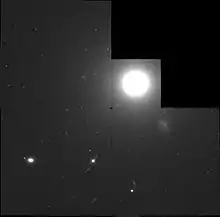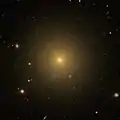NGC 1016
NGC 1016 is an elliptical galaxy approximately 287 million light-years away from Earth in the constellation of Cetus.[2][4] It was discovered by German astronomer Albert Marth on January 15, 1865 with William Lassell's 48" telescope on Malta.[5]
| NGC 1016 | |
|---|---|
 NGC 1016 (NASA/ESA HST) | |
| Observation data (J2000.0 epoch) | |
| Constellation | Cetus |
| Right ascension | 02h 38m 19.56s [1] |
| Declination | +02° 07′ 09.30″ [1] |
| Redshift | 0.022209 [1] |
| Helio radial velocity | 6658 ± 17 km/s [1] |
| Distance | 287 Mly [2] |
| Apparent magnitude (V) | 11.60 [3] |
| Apparent magnitude (B) | 12.60 [3] |
| Characteristics | |
| Type | E [1] |
| Apparent size (V) | 2.4 x 2.4 [1] |
| Other designations | |
| PGC 9997, MCG 0-7-67, UGC 2128 | |
References
- "NASA/IPAC Extragalactic Database". ned.ipac.caltech.edu. Retrieved December 6, 2017.
- Dullo, Bililign T.; Graham, Alister W. (2014). "Depleted cores, multi-component fits, and structural parameter relations for luminous early-type galaxies". Monthly Notices of the Royal Astronomical Society. 444 (3): 2700–2722. arXiv:1310.5867v2. Bibcode:2014MNRAS.444.2700D. doi:10.1093/mnras/stu1590. S2CID 119115650.
- "Revised NGC Data for NGC 1016". spider.seds.org. Retrieved December 9, 2017.
- "NGC 1016". Retrieved 2017-12-06.
- "Data for NGC 1016". www.astronomy-mall.com. Retrieved December 9, 2017.
External links
| Wikimedia Commons has media related to NGC 1016. |
- NGC 1016 on WikiSky: DSS2, SDSS, GALEX, IRAS, Hydrogen α, X-Ray, Astrophoto, Sky Map, Articles and images
- SEDS
This article is issued from Wikipedia. The text is licensed under Creative Commons - Attribution - Sharealike. Additional terms may apply for the media files.


